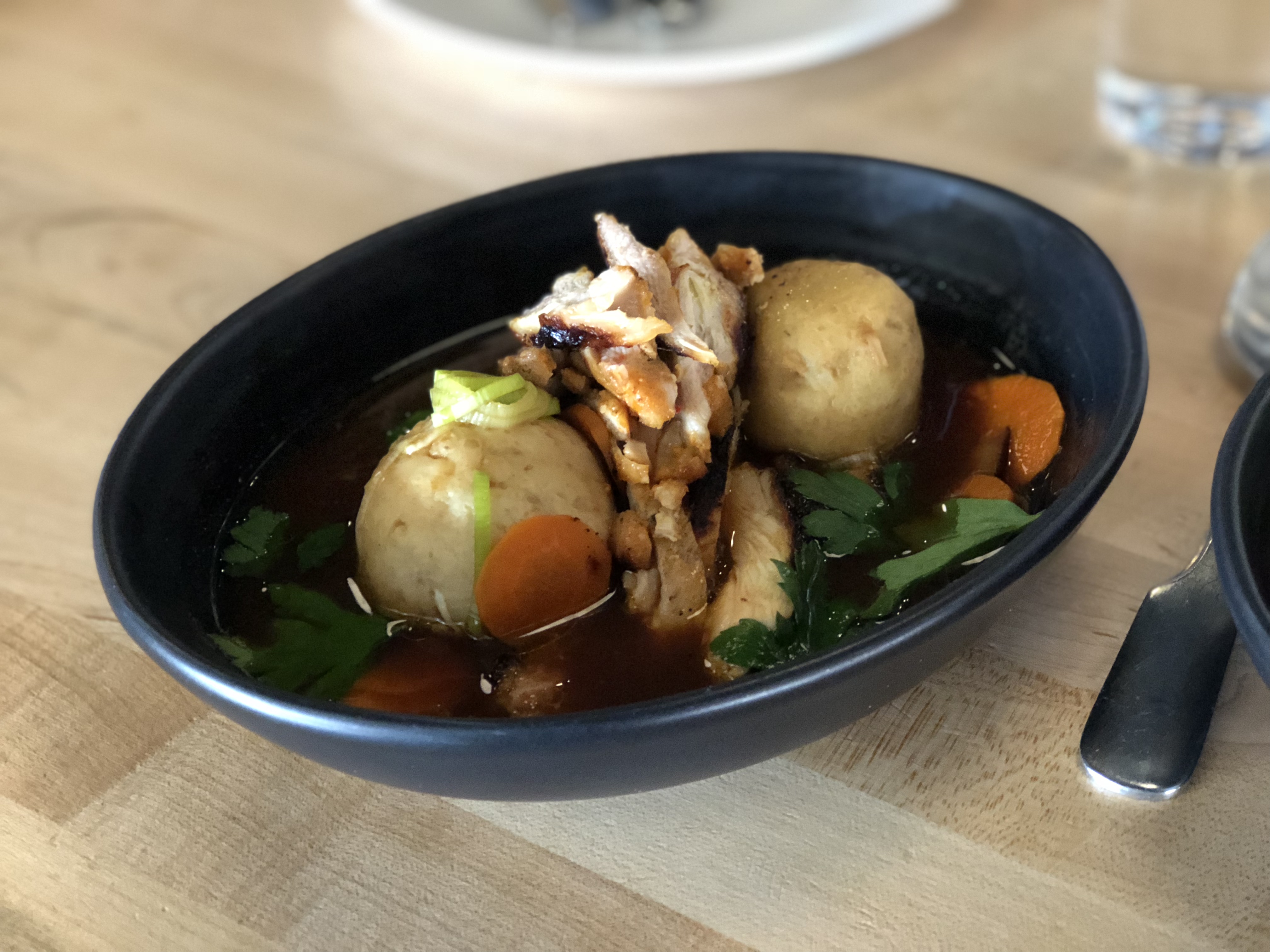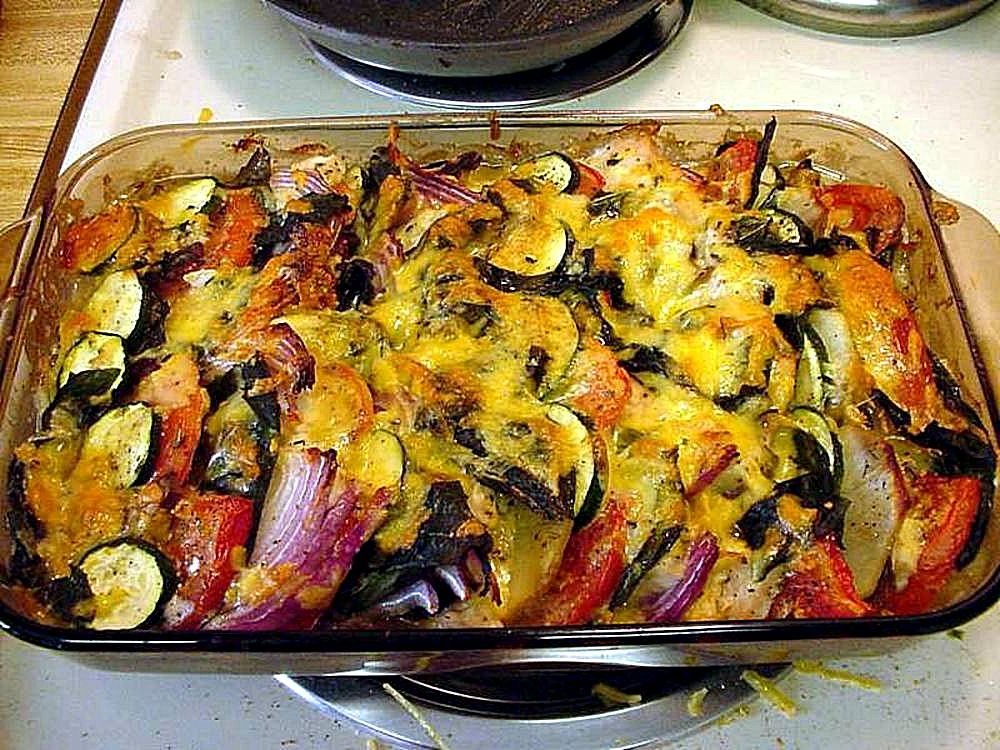|
Tzimmes
''Tzimmes'', or ''tsimmes'' (, ), is a traditional Ashkenazi Jewish stew typically made from carrots and dried fruits such as prunes or raisins, often combined with other root vegetables (including yam). Tzimmes is often part of the Rosh Hashanah meal, when it is traditional to eat sweet and honey-flavored dishes. Some cooks add chunks of meat (usually beef flank or brisket).Joan NathanJoan Nathan's Jewish Holiday Cookbook Schocken, 2004; page 228. The dish is cooked slowly over low heat and flavored with honey or sugar and sometimes cinnamon or other spices. The name is a Yiddish word that, according to the Oxford English Dictionary, may come from Middle High German ."tzimmes, n." OED Online, Oxford University Press, March 2022, www.oed.com/view/Entry/208475. Accessed 17 April 2022. "To make a big ''tzimmes'' over something" is a Yinglish expression that means to make a big fuss, perhaps because of the slicing, mixing, and stirring that go into the preparation of the dish. Se ... [...More Info...] [...Related Items...] OR: [Wikipedia] [Google] [Baidu] |
Jewish Cuisine
Jewish cuisine refers to the worldwide cooking traditions of the Jewish people. During its evolution over the course of many centuries, it has been shaped by Jewish dietary laws (''kashrut''), Jewish festivals and holidays, and traditions centred around Shabbat. Jewish cuisine is influenced by the economics, agriculture, and culinary traditions of the many countries where Jewish communities have settled and varies widely throughout the entire world. The history of Jewish cuisine begins with the cuisine of the ancient Israelites. As the Jewish diaspora grew, different styles of Jewish cooking developed. The distinctive styles in Jewish cuisine vary according to each community across the Ashkenazi, Sephardi, and Mizrahi diaspora groupings; there are also notable dishes within the culinary traditions of the standalone significant Jewish diaspora communities from Greece, Iran, and Yemen. Since the establishment of the State of Israel in 1948, and particularly since the late 19 ... [...More Info...] [...Related Items...] OR: [Wikipedia] [Google] [Baidu] |
Ashkenazi Jewish Cuisine
Ashkenazi Jewish cuisine is an assortment of Traditional food, cooking traditions that was developed by the Ashkenazi Jews of Central Europe, Central, Eastern Europe, Eastern, Northwestern Europe, Northwestern and Northern Europe, Northern Europe, and their descendants, particularly in the United States and other Western world, Western countries. Ashkenazi Jewish foods have frequently been unique to Ashkenazi Jewish communities, and they often consist of local ingredients (such as beets, cabbage, and potato). While these ingredients tended to be the same as those in local or neighbouring Gentile, non-Jewish communities, the preparation methods were very different due to ''kashrut'', which was historically enforced by a law, and a history of limited interaction between Ashkenazi Jews and non-Jews. The cuisine is largely based on ingredients that were affordable to the historically poor Ashkenazi Jewish community of Europe, and it is frequently composed of ingredients that were rea ... [...More Info...] [...Related Items...] OR: [Wikipedia] [Google] [Baidu] |
Rosh Hashanah
Rosh Hashanah (, , ) is the New Year in Judaism. The Hebrew Bible, biblical name for this holiday is Yom Teruah (, , ). It is the first of the High Holy Days (, , 'Days of Awe"), as specified by Leviticus 23:23–25, that occur in the late summer/early autumn of the Northern Hemisphere. Rosh Hashanah begins Ten Days of Repentance, ten days of penitence culminating in Yom Kippur, as well as beginning the cycle of autumnal religious festivals running through Sukkot which end on Shemini Atzeret in Israel and Simchat Torah everywhere else. Rosh Hashanah is a Jewish holidays#Second day of biblical festivals, two-day observance and celebration that begins on the first day of Tishrei, which is the seventh month of the Hebrew calendar#New year, ecclesiastical year. In contrast to the ecclesiastical Lunar New Year#Middle East/West Asia, lunar new year on the first day of the first month Nisan, the spring Passover month which marks Israel's exodus from Egypt, Rosh Hashanah marks the beginn ... [...More Info...] [...Related Items...] OR: [Wikipedia] [Google] [Baidu] |
Sweet Potato Pear Tzimmes (140491615)
Sweetness is a basic taste most commonly perceived when eating foods rich in sugars. Sweet tastes are generally regarded as pleasurable. In addition to sugars like sucrose, many other chemical compounds are sweet, including aldehydes, ketones, and sugar alcohols. Some are sweet at very low concentrations, allowing their use as non-caloric sugar substitutes. Such non-sugar sweeteners include saccharin, aspartame, sucralose and stevia. Other compounds, such as miraculin, may alter perception of sweetness itself. The perceived intensity of sugars and high-potency sweeteners, such as aspartame and neohesperidin dihydrochalcone, are heritable, with gene effect accounting for approximately 30% of the variation. The chemosensory basis for detecting sweetness, which varies between both individuals and species, has only begun to be understood since the late 20th century. One theoretical model of sweetness is the multipoint attachment theory, which involves multiple binding sites betw ... [...More Info...] [...Related Items...] OR: [Wikipedia] [Google] [Baidu] |
Yiddish
Yiddish, historically Judeo-German, is a West Germanic language historically spoken by Ashkenazi Jews. It originated in 9th-century Central Europe, and provided the nascent Ashkenazi community with a vernacular based on High German fused with many elements taken from Hebrew language, Hebrew (notably Mishnaic Hebrew, Mishnaic) and to some extent Aramaic. Most varieties of Yiddish include elements of Slavic languages and the vocabulary contains traces of Romance languages.Aram Yardumian"A Tale of Two Hypotheses: Genetics and the Ethnogenesis of Ashkenazi Jewry".University of Pennsylvania. 2013. Yiddish has traditionally been written using the Hebrew alphabet. Prior to World War II, there were 11–13 million speakers. 85% of the approximately 6 million Jews who were murdered in the Holocaust were Yiddish speakers,Solomon Birnbaum, ''Grammatik der jiddischen Sprache'' (4., erg. Aufl., Hamburg: Buske, 1984), p. 3. leading to a massive decline in the use of the language. Jewish ass ... [...More Info...] [...Related Items...] OR: [Wikipedia] [Google] [Baidu] |
Casserole Dishes
A casserole ( French: diminutive of , from Provençal , meaning 'saucepan') is a kind of large, deep pan or bowl used for cooking a variety of dishes in the oven; it is also a category of foods cooked in such a vessel. To distinguish the two uses, the pan can be called a "casserole dish" or "casserole pan", whereas the food is simply "a casserole". The same pan is often used both for cooking and for serving. History Baked dishes have existed for thousands of years. Early casserole recipes consisted of rice that was pounded, pressed, and filled with a savoury mixture of meats such as chicken or sweetbread. Sometime around the 1870s the casserole seems to have taken on its current definition. Cooking in earthenware containers has always been common in most cultures, but the idea of casserole cooking as a one-dish meal became popular in the United States in the twentieth century, especially in the 1950s when new forms of lightweight metal and glass cookware appeared on the ... [...More Info...] [...Related Items...] OR: [Wikipedia] [Google] [Baidu] |
List Of Carrot Dishes
This is a list of carrot dishes and foods, which use carrot as a primary ingredient. The carrot (''Daucus carota'' subsp. ''sativus'') is a root vegetable, usually orange in colour, though purple, red, white, and yellow varieties exist. Carrot dishes * * Carrot bread – a bread or quick bread that uses carrot as a primary ingredient * Carrot cake * Carrot cake cookie * Carrot chips – sliced carrots that have been fried or dehydrated * Carrot hot dog - carrot cured in hot dog spices and grilled * Carrot juice – has a uniquely sweet flavor of concentrated carrots, and is often consumed as a health drink * Carrot jam - a Portuguese delicacy * Carrot pudding – can be served as either a savory pudding or as a sweet dessert * Carrot salad – recipes vary widely by regional cuisine, and shredded carrot is often used. Shredded carrot salads are also sometimes used as a topping for other dishes. ** Morkovcha – a Koryo-saram (Koreans of the former Soviet Union) dish, va ... [...More Info...] [...Related Items...] OR: [Wikipedia] [Google] [Baidu] |
Israeli Cuisine
Israeli cuisine primarily comprises dishes brought from the Jewish diaspora, and has more recently been defined by the development of a notable fusion cuisine characterized by the mixing of Jewish cuisine and Arab cuisine.Gold, Rozann''A Region's Tastes Commingle in Israel'' (July 20, 1994) in ''The New York Times'' Retrieved 2010–02–14 It also blends together the culinary traditions of the various diaspora groups, namely those of Mizrahi Jewish cuisine, Middle Eastern Jews with roots in Jewish exodus from the Muslim world, Southwest Asia and North Africa, Sephardic Jewish cuisine, Sephardi Jews from History of the Jews in Spain, Iberia, and Ashkenazi Jewish cuisine, Ashkenazi Jews from History of the Jews in Europe, Central and Eastern Europe. The country's cuisine also incorporates food and drinks traditionally included in other Middle Eastern cuisines (e.g., Iranian cuisine from Persian Jews and Turkish cuisine from Turkish Jews in Israel, Turkish Jews) as well as in Medite ... [...More Info...] [...Related Items...] OR: [Wikipedia] [Google] [Baidu] |
Yinglish
Yiddish words used in the English language include both words that have been Language shift, assimilated into English language, Englishused by both Yiddish and English speakersand many that have not. An English sentence that uses either may be described by some as Yinglish, though a secondary sense of the term describes the distinctive way certain Jews in English-speaking countries add many Yiddish words into their conversation, beyond general Yiddish words and phrases used by English speakers. Many of these words have not been assimilated into English and are unlikely to be understood by English speakers who do not have substantial Yiddish knowledge. Leo Rosten's book ''The Joys of Yiddish'' explains these words (and many more) in detail. Yinglish ''Yinglish'' words (also referred to colloquially as ''Hebronics'') are neologisms created by speakers of Yiddish in English-speaking countries, sometimes to describe things that were uncommon in the old country. Leo Rosten's book ''The ... [...More Info...] [...Related Items...] OR: [Wikipedia] [Google] [Baidu] |
Middle High German
Middle High German (MHG; or ; , shortened as ''Mhdt.'' or ''Mhd.'') is the term for the form of High German, High German language, German spoken in the High Middle Ages. It is conventionally dated between 1050 and 1350, developing from Old High German (OHG) into Early New High German (ENHG). High German is defined as those varieties of German which were affected by the High German consonant shift, Second Sound Shift; the Middle Low German (MLG) and Middle Dutch languages spoken to the North and North West, which did not participate in this sound change, are not part of MHG. While there is no ''standard'' MHG, the prestige of the Hohenstaufen court gave rise in the late 12th century to a supra-regional literary language () based on Swabian dialect, Swabian, an Alemannic German, Alemannic dialect. This historical interpretation is complicated by the tendency of modern editions of MHG texts to use ''normalised'' spellings based on this variety (usually called "Classical MHG"), which ... [...More Info...] [...Related Items...] OR: [Wikipedia] [Google] [Baidu] |
Oxford English Dictionary
The ''Oxford English Dictionary'' (''OED'') is the principal historical dictionary of the English language, published by Oxford University Press (OUP), a University of Oxford publishing house. The dictionary, which published its first edition in 1884, traces the historical development of the English language, providing a comprehensive resource to scholars and academic researchers, and provides ongoing descriptions of English language usage in its variations around the world. In 1857, work first began on the dictionary, though the first edition was not published until 1884. It began to be published in unbound Serial (literature), fascicles as work continued on the project, under the name of ''A New English Dictionary on Historical Principles; Founded Mainly on the Materials Collected by The Philological Society''. In 1895, the title ''The Oxford English Dictionary'' was first used unofficially on the covers of the series, and in 1928 the full dictionary was republished in 10 b ... [...More Info...] [...Related Items...] OR: [Wikipedia] [Google] [Baidu] |
Sugar
Sugar is the generic name for sweet-tasting, soluble carbohydrates, many of which are used in food. Simple sugars, also called monosaccharides, include glucose Glucose is a sugar with the Chemical formula#Molecular formula, molecular formula , which is often abbreviated as Glc. It is overall the most abundant monosaccharide, a subcategory of carbohydrates. It is mainly made by plants and most algae d ..., fructose, and galactose. Compound sugars, also called disaccharides or double sugars, are molecules made of two bonded monosaccharides; common examples are sucrose (glucose + fructose), lactose (glucose + galactose), and maltose (two molecules of glucose). White sugar is almost pure sucrose. In the body, compound sugars are hydrolysed into simple sugars. Longer chains of monosaccharides (>2) are not regarded as sugars and are called oligosaccharides or polysaccharides. Starch is a glucose polymer found in plants, the most abundant source of energy in human foo ... [...More Info...] [...Related Items...] OR: [Wikipedia] [Google] [Baidu] |







